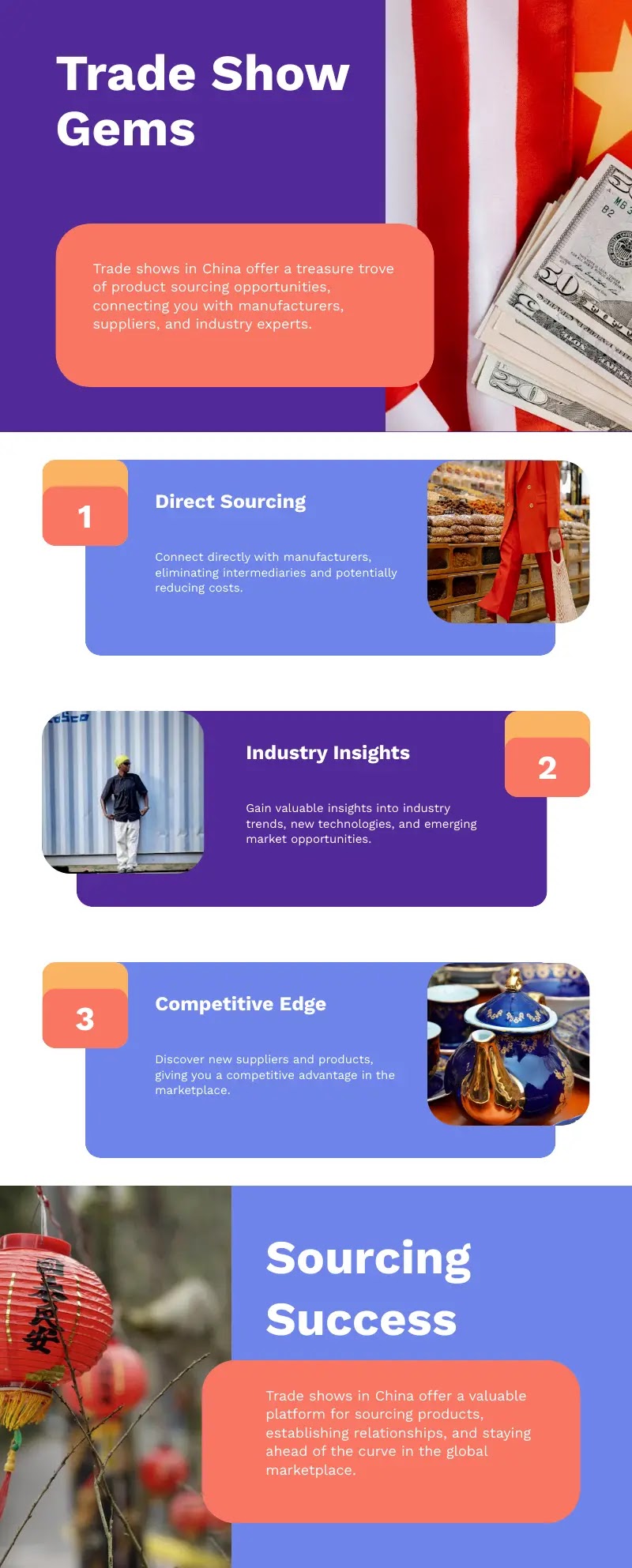
In the bustling world of e-commerce and retail, the art of product sourcing plays a pivotal role in determining success.
It’s the backbone of discovering products that meet market demand, maintain quality, and drive profitability.
Today, we’re taking a deep dive into a case study that explores the intricate process of product sourcing at trade shows — a goldmine for retailers seeking unique and profitable products.
Product sourcing involves finding the right products to sell, and it’s essential for any business aiming to thrive.
There are several methods to achieve this, from collaborating with manufacturers and wholesalers to venturing into dropshipping.
Each approach has its own set of advantages and challenges, making it vital for businesses to find the right fit for their specific needs.
This article offers a case study approach to understanding product sourcing at trade shows. We’ll explore the steps involved, the challenges faced, and the outcomes achieved
By the end, you’ll gain valuable insights into how trade shows can be a powerful tool in your product sourcing strategy.
Understanding Product Sourcing
What is Product Sourcing?
Product sourcing refers to the process of finding and acquiring products to sell in your business.
It encompasses various methods such as working with manufacturers who produce the goods, partnering with wholesalers who offer bulk discounts, or utilizing dropshipping where products are shipped directly from the supplier to the customer.
Each sourcing method has its unique benefits. Manufacturers can offer exclusive products tailored to your brand, while wholesalers provide cost-effective purchasing options in bulk.
Dropshipping, on the other hand, eliminates the need for inventory storage and management, making it a popular choice for startups.
Understanding these different methods allows businesses to choose the most suitable one based on their goals, resources, and target market. The flexibility of product sourcing ensures that businesses can adapt to changing market trends and consumer preferences.
Definition of Product Sourcing
Product sourcing is the strategic process through which businesses identify, evaluate, and select products to sell, thereby forming the backbone of their inventory and sales strategy.
This process is crucial as it directly impacts the quality, cost, and variety of the offerings provided to customers.
By forging relationships with manufacturers, wholesalers, or suppliers, companies can consistently bring desirable products to the market.
Effective product sourcing not only helps businesses maintain a competitive edge by offering unique or cost-efficient goods but also ensures adaptability to shifting consumer demands and market trends.
In essence, successful product sourcing is vital for optimizing profit margins and sustaining long-term growth within any industry.
Importance of Product Sourcing
Effective product sourcing is essential for business success. It directly impacts your ability to offer quality products at competitive prices, manage inventory efficiently, and meet customer expectations.
Businesses that excel in product sourcing can control costs, enhance quality assurance, and improve their supply chain management.
By sourcing products strategically, businesses can achieve significant cost savings, allowing them to allocate resources to other critical areas such as marketing and customer service.
Additionally, having control over the quality of sourced products ensures customer satisfaction and brand reputation.
Furthermore, effective inventory management through strategic sourcing minimizes the risk of overstocking or stockouts, leading to better cash flow management and increased profitability.
In a competitive market, mastering product sourcing gives businesses a distinct advantage.
The Role of Trade Shows in Product Sourcing
Overview of Trade Shows
Trade shows serve as dynamic platforms for businesses across industries to showcase their products, network with industry professionals, and explore new trends.
These events bring together suppliers, manufacturers, distributors, and retailers under one roof, creating opportunities for collaboration and innovation.
Trade shows vary in nature and focus. Some are industry-specific, catering to niche markets, while others are broad, attracting a diverse audience.
For businesses engaged in product sourcing, trade shows provide a unique opportunity to discover new products, gain insights into industry innovations, and form valuable connections.
Through interactive demonstrations, attendees can experience products firsthand, facilitating informed decisions about potential sourcing partnerships.
Trade shows are not only about showcasing products but also about creating a space for dialogue, learning, and growth within an industry.
Benefits of Attending Trade Shows for Product Sourcing
Attending trade shows offers several benefits for product sourcing. Firstly, these events provide unparalleled networking opportunities. Business owners and decision-makers have the chance to connect directly with suppliers and manufacturers, building relationships that can lead to fruitful collaborations.
Secondly, trade shows expose attendees to new products and emerging trends.
Staying updated with industry developments is crucial for businesses aiming to stay competitive and relevant in the market. Trade shows offer a firsthand look at what’s trending and what’s coming next.
Lastly, face-to-face negotiations and relationship-building are invaluable at trade shows.
In an age of digital communication, meeting potential partners in person can foster trust and open doors to more flexible agreements and better deals. Trade shows provide a unique environment for these interactions.
Expanding Market Knowledge
Attending trade shows significantly enhances a company’s market knowledge.
Being present among industry leaders and innovators allows participants to learn about various strategies and approaches to product development and marketing.
Insights gained from keynote speakers, workshops, and display exhibits can provide a broader understanding of the market landscape, offering a competitive edge in strategy formulation.
Furthermore, trade shows often highlight consumer preferences and emerging demands, empowering businesses to tailor their sourcing strategies to meet market needs effectively.
Cost-Effective Sourcing Solutions
Trade shows can also be a cost-effective platform for product sourcing.
With a vast number of suppliers gathered in one location, businesses can compare prices, quality, and services without incurring additional travel costs.
This concentrated environment enables companies to negotiate bulk deals or long-term agreements on more favorable terms.
Recognizing the right supplier at a trade show can lead to significant cost savings, easing budget constraints and optimizing product lines.
Hands-On Product Evaluation
One significant advantage of trade shows is the opportunity for hands-on product evaluation. Attendees can see, feel, and test products, which is not possible through catalogs or online images, ensuring they make informed decisions.
This tactile interaction can help in assessing product quality and functionality, ensuring that the sourced products meet the company’s standards and customer expectations.
This direct experience reduces the risk associated with new product investments, making trade shows an ideal setting for comprehensive product evaluation and selection.
Case Study Overview
Introduction to the Case Study
In this case study, we follow the journey of a small retail business, “EcoTrends,” as they embarked on their first trade show experience. With a focus on sustainable and eco-friendly products, EcoTrends sought to expand its product line and enhance its brand’s appeal.
Their objective was clear — to find unique, high-quality products that aligned with their brand values and resonated with their environmentally conscious customer base.
Attending a trade show dedicated to eco-friendly products seemed like the perfect opportunity to achieve this goal.
Through this case study, we’ll explore how EcoTrends approached the trade show, what they learned along the way, and the impact it had on their business strategy. Their experience serves as a valuable example for other businesses considering trade shows for product sourcing.
Trade Show Details
EcoTrends attended the “Green Living Expo,” a renowned trade show hosted in San Francisco, USA. The event spanned three days, from April 15th to 17th, and attracted over 200 exhibitors from various industries related to sustainability.
The Green Living Expo focuses on showcasing innovative and environmentally friendly products, making it an ideal platform for EcoTrends to discover potential partnerships. With a wide range of exhibitors, the expo provided ample opportunities to explore diverse product offerings.
The significance of this trade show extended beyond product discovery. It offered EcoTrends the chance to engage with like-minded businesses, learn about industry advancements, and gain inspiration for future product development. The expo was a melting pot of ideas and possibilities.
Product Sourcing Process at the Trade Show
Pre-Show Preparation
Before attending the trade show, EcoTrends conducted thorough research on the exhibitors and products that would be showcased. This preparation allowed them to identify key suppliers and prioritize their interactions during the event. Setting clear goals and objectives for sourcing was a crucial step in maximizing their time and efforts.
Having a well-defined plan ensured that EcoTrends could focus on meeting suppliers aligned with their values and requirements. They prepared a checklist of questions to ask potential partners, aiming to gather crucial information about product quality, pricing, and terms.
By entering the trade show with a clear strategy, EcoTrends was able to make the most of their time, identifying opportunities that matched their business goals while avoiding unnecessary distractions. Their proactive approach laid the groundwork for successful sourcing.
Attending the Trade Show
During the trade show, EcoTrends employed effective networking strategies to engage with suppliers and manufacturers. They actively participated in product demonstrations, took detailed notes, and gathered samples to evaluate the suitability of potential products.
Evaluating products and suppliers on-site was a critical aspect of their sourcing process. EcoTrends considered factors such as product quality, eco-certifications, and supplier reliability to make informed decisions. These evaluations were instrumental in narrowing down their options.
Additionally, EcoTrends recognized the importance of building relationships with suppliers. They expressed genuine interest in the supplier’s business, which helped establish rapport and fostered trust. Building strong connections during the trade show paved the way for successful post-show negotiations.
Post-Show Follow-Up
Following the trade show, EcoTrends implemented a systematic approach to evaluate leads and contacts made during the event. They organized the information gathered, analyzed supplier offerings, and compared them against their sourcing criteria.
Timely follow-up and communication played a pivotal role in converting trade show interactions into meaningful partnerships. EcoTrends reached out to potential suppliers within a week, expressing their interest in further discussions and negotiations.
Maintaining relationships with suppliers was a priority for EcoTrends. Regular communication and updates on their sourcing needs helped strengthen these connections, leading to long-term collaborations and mutually beneficial outcomes.
Challenges Faced in Product Sourcing at Trade Shows
Common Challenges
Despite their thorough preparation, EcoTrends encountered several challenges during the trade show. The overwhelming number of options and information was a common hurdle, making it difficult to assess and prioritize potential suppliers.
Another challenge was evaluating product quality and supplier reliability. With limited time to inspect products and verify supplier credentials, making informed decisions required careful consideration and attention to detail.
Time management posed yet another challenge. Balancing between engaging with suppliers, attending seminars, and exploring the trade show floor demanded efficient planning and allocation of time.
Solutions and Best Practices
To overcome these challenges, EcoTrends implemented several best practices. They created a sourcing checklist that outlined their criteria for supplier selection, ensuring that they focused on key factors that mattered most to their business.
They also prioritized quality over quantity by narrowing down their list of potential suppliers to a manageable number. This allowed them to invest more time in evaluating each option thoroughly.
Additionally, EcoTrends embraced a collaborative approach by involving multiple team members in the sourcing process. Having diverse perspectives and expertise helped them make well-rounded decisions and address any uncertainties effectively.
Results and Outcomes of the Case Study
Success Metrics
EcoTrends measured their success using key performance indicators (KPIs) such as the number of successful supplier partnerships, cost savings achieved through negotiations, and the variety of unique products added to their inventory.
By comparing their pre-show and post-show sourcing effectiveness, they observed a significant improvement in their ability to source high-quality products that resonated with their target audience. The trade show experience proved to be a game-changer for their business.
The success of EcoTrends at the trade show not only enhanced their product offerings but also boosted their brand credibility and customer satisfaction. Their ability to curate a diverse and eco-friendly product line sets them apart in the market.
Lessons Learned
The case study of EcoTrends highlights valuable lessons for businesses considering trade shows for product sourcing. Firstly, thorough preparation and research are essential for maximizing trade show opportunities.
Secondly, effective networking and relationship-building play a critical role in sourcing success. Building rapport with suppliers can lead to more favorable terms and long-term partnerships.
Lastly, having a clear strategy for post-show follow-up ensures that valuable leads are nurtured and converted into meaningful business relationships. Timely communication and follow-up are key to reaping the benefits of trade show participation.
Importance of Having a Sourcing Checklist
Having a detailed sourcing checklist is crucial for businesses aiming to optimize their trade show participation and product sourcing processes.
A well-structured checklist ensures that no critical steps are overlooked, from pre-show preparations to post-show follow-up actions. It serves as a roadmap, guiding the team through each phase and allowing them to focus on strategic objectives rather than getting bogged down in logistical details.
This structured approach enhances efficiency, making it easier to evaluate potential suppliers, assess product quality, and keep track of leads.
Additionally, a sourcing checklist helps maintain consistency across sourcing efforts, which is vital for measuring success and making improvements over time.
By keeping the team aligned and organized, a checklist can significantly increase the likelihood of achieving desired outcomes, thereby maximizing the return on investment from trade show activities.
Key Performance Indicators (KPIs) Used to Measure Success
To effectively evaluate the success of trade show participation and sourcing efforts, businesses must implement key performance indicators (KPIs) that align with their strategic objectives. One essential KPI is the number of qualified leads generated, which provides insight into the potential for future business relationships.
Additionally, measuring the conversion rate of these leads into actual sales can directly reflect the success of the follow-up strategy.
Another critical KPI is the cost per lead, which helps determine the return on investment by evaluating the efficiency of resource allocation during the event.
Customer acquisition cost (CAC) is equally important, as it assesses the overall expenditure needed to secure new clients compared to the revenue generated.
Lastly, tracking the long-term value of new partnerships formed at trade shows can provide significant motivation for ongoing participation, highlighting the strategic benefits of networking and relationship-building efforts.
By leveraging these KPIs, businesses can gain a comprehensive understanding of their trade show performance and adjust strategies for continuous improvement.
Conclusion
In conclusion, product sourcing is a vital component of business success. Trade shows offer a unique platform for businesses to discover new products, build relationships, and gain insights into industry trends.
The case study of EcoTrends demonstrates the potential of trade shows as a viable option for product sourcing. By leveraging these events, businesses can gain access to diverse products, establish valuable partnerships, and enhance their brand’s market position.
We encourage readers to consider trade shows as part of their product-sourcing strategy.
Share your experiences or ask questions about product sourcing in the comments below. Let’s continue the conversation and explore the possibilities together.
FAQs About Product Sourcing at Trade Shows
What should businesses look for when sourcing products at trade shows?
A: Businesses should focus on identifying suppliers who offer high-quality products, competitive pricing, and reliable delivery schedules. It’s also essential to assess the supplier’s reputation and their ability to meet the business’s specific needs and standards.
How can businesses effectively prepare for a trade show to optimize product sourcing?
A: Preparation involves thorough research on the exhibitors, setting clear objectives, and scheduling meetings with potential suppliers in advance. Having a well-defined sourcing plan and allocating time for exploring various booths and networking is beneficial.
What are the common mistakes businesses make when sourcing products at trade shows?
A: Common mistakes include not doing adequate research beforehand, failing to follow up with contacts made during the show, and not clearly understanding their product requirements. Businesses should also only make hasty decisions after thoroughly evaluating the potential suppliers.
How do trade shows compare with online product sourcing?
A: Trade shows provide a hands-on experience where businesses can physically inspect products, engage directly with suppliers, and foster personal relationships, which is often not possible with online sourcing.
However, online sourcing can offer a broader range of options and convenience without the need for travel.
How can the relationships formed at trade shows benefit long-term product sourcing?
A: Building strong relationships at trade shows can lead to trusted partnerships, exclusive deals, and insights into future product developments.
These relationships often result in better negotiation terms, enhanced collaboration, and a competitive edge in the market.



